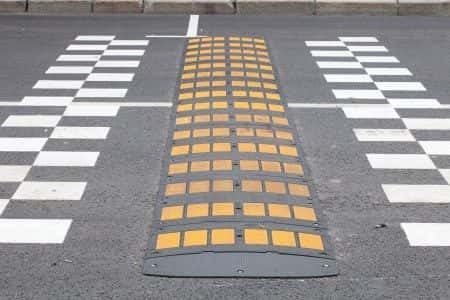Plaintiff, who is in her 60s and residing in Utah, parked her car in the parking lot and was walking toward a business. To reach the entrance, she used the motor vehicle access aisle in front of the building. As she was walking, one of her feet caught on a speed bump situated across the access aisle. She lost her balance and fell forward, landing on the pavement. She knew the speed bump was present and tried to step over it. The fall caused serious injuries.
Question(s) For Expert Witness
1. Should the speed bump have been located near the entrance?
2. Was it a tripping hazard? Did it violate any statutes or codes?
Expert Witness Response
It is apparent from the description of the incident that plaintiff tripped on a raised element in the walking surface. It is of interest to examine the characteristics of the walking surface to determine their role in this incident. The best way to evaluate minimum safe practices with respect to pedestrian facilities is to use nationally accepted guidelines as the criteria. Since it is used by pedestrians at this location to travel between the entrance to the building and the parking lot, the vehicular access aisle outside of the building also represents part of a pedestrian facility. A great deal is known about the safe design, inspection and maintenance of pedestrian facilities; such information is well-documented in the technical literature.
It is apparent from both the facility safety and traffic engineering literature that speed bumps pose a trip and fall hazard for pedestrians. The literature is also clear that speed bumps should not be used in parking lot aisles where it is foreseeable that pedestrians will cross them. Consequently, where speed bumps are placed on the traffic access aisles, it is foreseeable that pedestrians will trip on them and fall.
A photograph of the speed bump shows that a significant amount of paint has been removed from the face of the bump and that the surface is rough and damaged. Plaintiff’s foot would have struck the left side of the bump; it appears from the photograph that the slope of this side of the bump does not meet the ramping requirements for a change in level in a pedestrian path because of its steepness. It is clear that due to weathering and traffic, the bump has become chipped and broken such that there are vertical edges greater than one-quarter inch in height. Therefore, in my opinion, the bump itself (including the damaged areas) presented a tripping hazard for pedestrians. It was foreseeable that pedestrians moving between the parking lot and the building entrance would trip and fall on the speed bump.
Reasonable and prudent facility inspection and maintenance practices would recognize that such deterioration is expected on a device that is exposed to the elements and to vehicular traffic. Given that there was apparently no intention of removing the bump, clearly, steps should have been taken to make sure that the bump was painted on a regular basis and that surface defects were repaired. Failure to perform such maintenance is neither reasonable nor prudent facility maintenance practice. I conclude that the property manager was aware or should have been aware of the problems just described.
In conclusion, the elevation difference (created by the speed bump) in the walkway located outside of the building constituted a dangerous condition of the premises, wherein falls of the type which occurred were foreseeable. The condition of the walking surface violated Sections 5.2 and 5.7 of ASTM F 1637 and Section 302.3 of the International Property Maintenance Code and was dangerous. Because the area was used by pedestrians who were exposed to the serious safety hazards attributable to the non-conforming walking surface, it is my opinion within a reasonable degree of engineering certainty that the defendant failed to use reasonable care and follow prudent practices relative to the design, inspection and maintenance of the walking surface. The incident that occurred and the injuries that resulted were a direct result of their actions/inactions.
About the author
Kristin Casler
Kristin Casler is a seasoned legal writer and journalist with an extensive background in litigation news coverage. For 17 years, she served as the editor for LexisNexis Mealey’s litigation news monitor, a role that positioned her at the forefront of reporting on pivotal legal developments. Her expertise includes covering cases related to the Supreme Court's expert admissibility ruling in Daubert v. Merrell Dow Pharmaceuticals Inc., a critical area in both civil and criminal litigation concerning the challenges of 'junk science' testimony.
Kristin's work primarily involves reporting on a diverse range of legal subjects, with particular emphasis on cases in asbestos litigation, insurance, personal injury, antitrust, mortgage lending, and testimony issues in conviction cases. Her contributions as a journalist have been instrumental in providing in-depth, informed analysis on the evolving landscape of these complex legal areas. Her ability to dissect and communicate intricate legal proceedings and rulings makes her a valuable resource in the legal journalism field.



